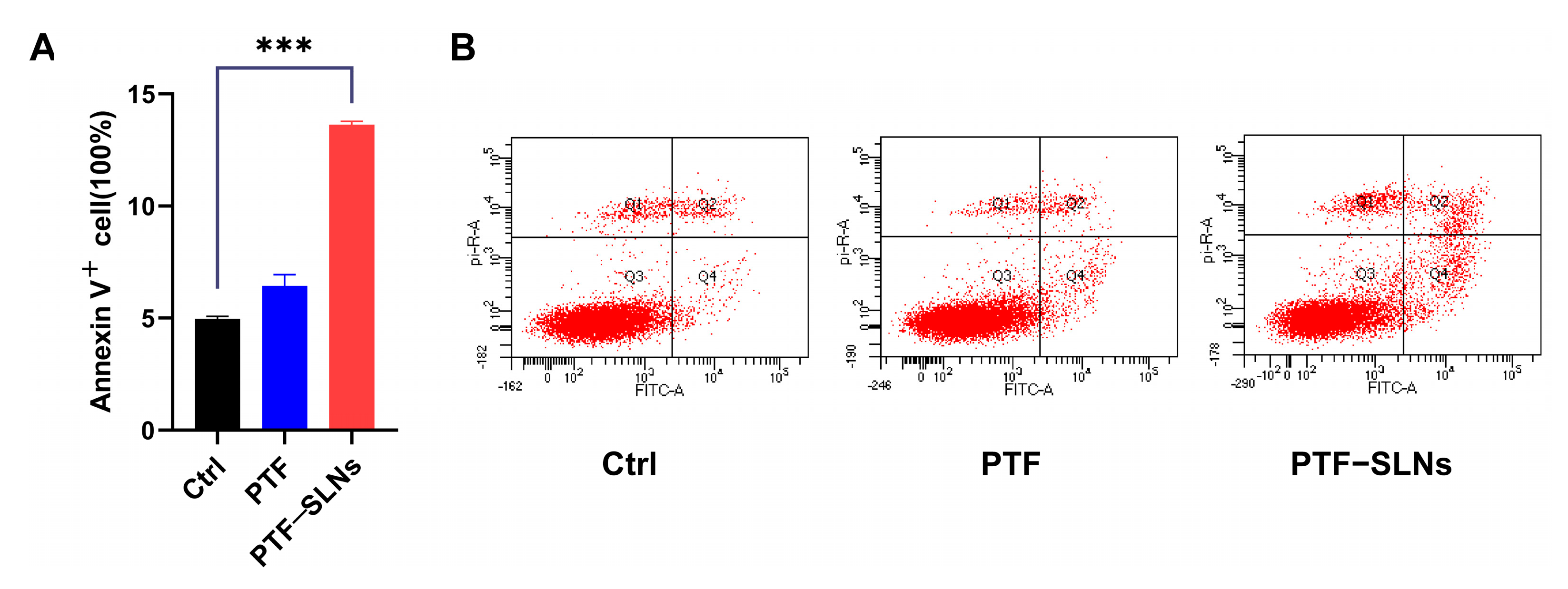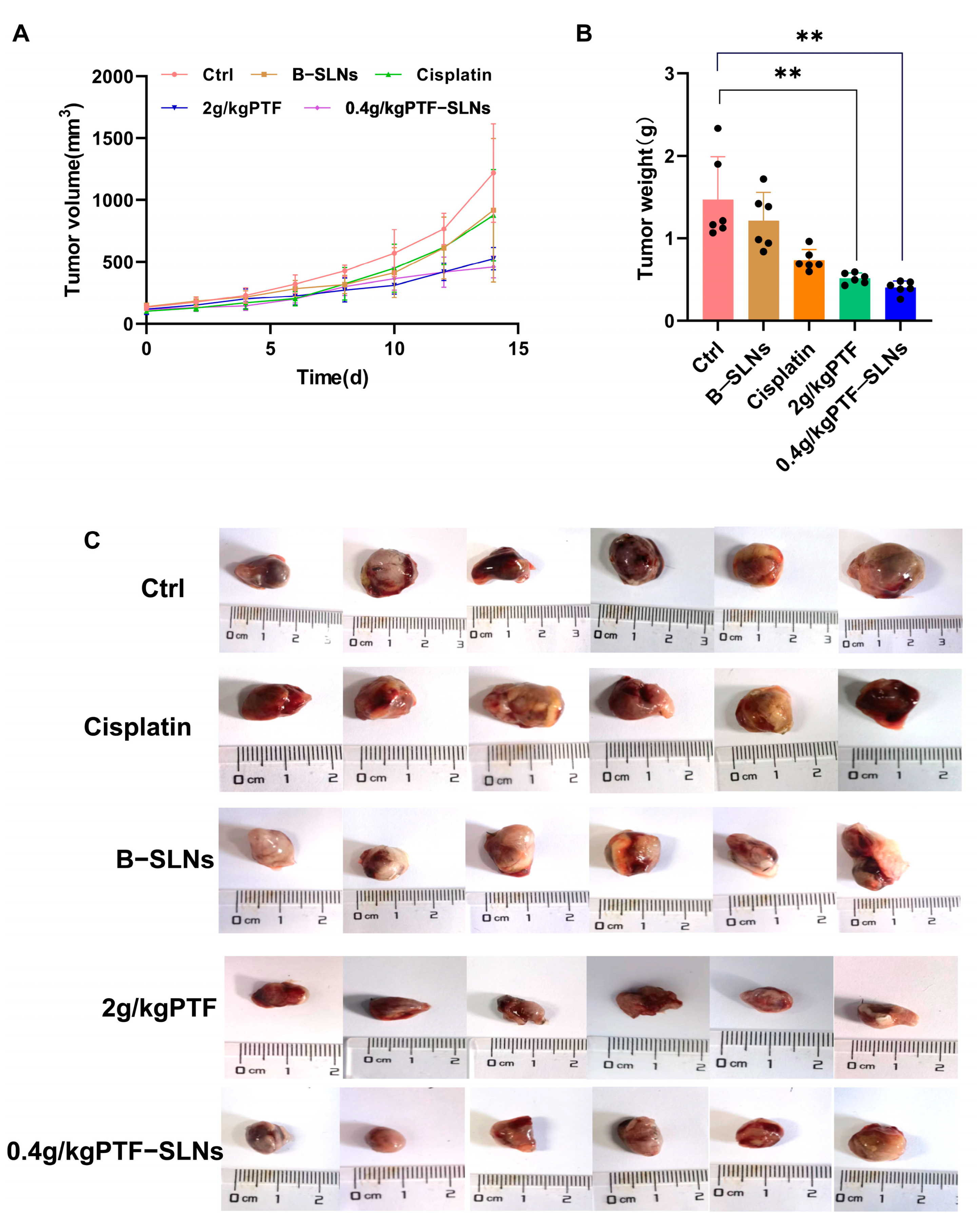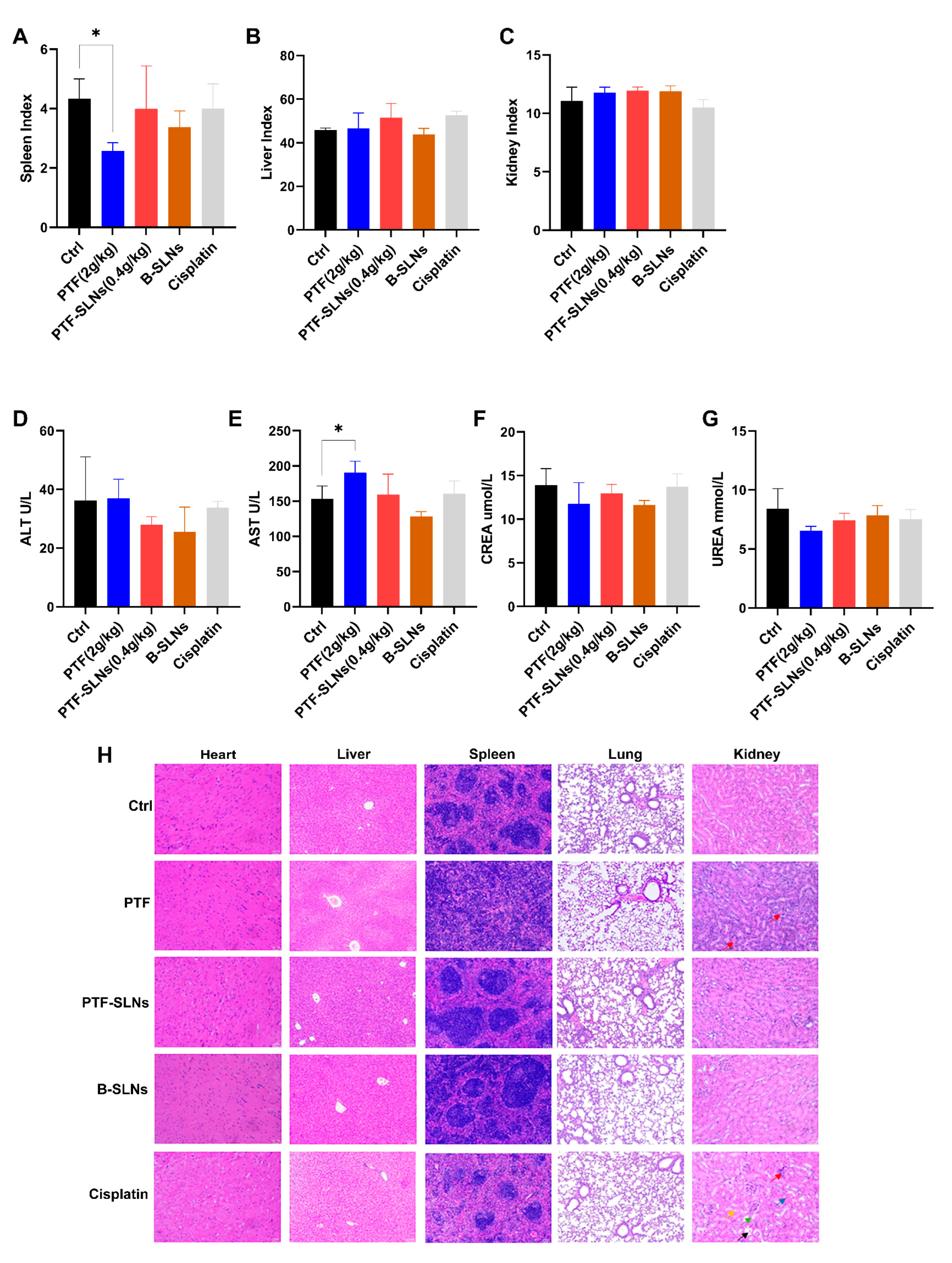Phyllanthi Tannin Loaded Solid Lipid Nanoparticles for Lung Cancer Therapy: Preparation, Characterization, Pharmacodynamics and Safety Evaluation
Abstract
:1. Introduction
2. Results and Discussion
2.1. Optimization of PTF-SLNs
2.2. HPLC Analysis
2.3. Characteristics of PTF-SLNs
2.4. Cytotoxicity Assay
2.5. Apoptosis Assay
2.6. Anti-Tumor Effect of PTF-SLNs
2.7. Safety Preliminary Study
2.7.1. Organ Index
2.7.2. Measurement of AST, ALT, CREA, and UREA
2.7.3. Histopathological Examination
3. Materials and Methods
3.1. Plant Material
3.2. Materials and Reagents
3.3. Preparation of SLNs
3.4. HPLC Analysis
3.5. Detection of Total Phenolic and Tannin Content
3.6. Characteristics of PTF-SLNs
3.7. In Vitro Study
3.8. CCK8 Assay
3.9. Apoptosis Analysis
3.10. Anti-Tumor Efficacy
3.11. Safety Preliminary Study
3.12. Statistical Analysis
4. Conclusions
Author Contributions
Funding
Institutional Review Board Statement
Informed Consent Statement
Data Availability Statement
Conflicts of Interest
References
- Sung, H.; Ferlay, J.; Siegel, R.L.; Laversanne, M.; Soerjomataram, I.; Jemal, A.; Bray, F. Global cancer statistics 2020: Globocan estimates of incidence and mortality worldwide for 36 cancers in 185 countries. CA Cancer J. Clin. 2021, 71, 209–249. [Google Scholar] [CrossRef] [PubMed]
- Duma, N.; Santana-Davila, R.; Molina, J.R. Non-Small Cell Lung Cancer: Epidemiology, Screening, Diagnosis, and Treatment. Mayo Clin. Proc. 2019, 94, 1623–1640. [Google Scholar] [CrossRef] [PubMed]
- Postmus, P.E.; Kerr, K.M.; Oudkerk, M.; Senan, S.; Waller, D.A.; Vansteenkiste, J.; Escriu, C.; Peters, S. Early and locally advanced non-small-cell lung cancer (NSCLC): ESMO Clinical Practice Guidelines for diagnosis, treatment and follow-up. Ann. Oncol. 2017, 28 (Suppl. 4), iv1–iv21. [Google Scholar] [CrossRef] [PubMed]
- Abdul-Ghafar, J.; Oh, S.S.; Park, S.M.; Wairagu, P.; Lee, S.N.; Jeong, Y.; Eom, M.; Yong, S.J.; Jung, S.H. Expression of adiponectin receptor 1 is indicative of favorable prognosis in non-small cell lung carcinoma. Tohoku J. Exp. Med. 2013, 229, 153–162. [Google Scholar] [CrossRef] [PubMed]
- Liu, R.H. Potential synergy of phytochemicals in cancer prevention: Mechanism of action. J. Nutr. 2004, 134 (Suppl. 12), 3479S–3485S. [Google Scholar] [CrossRef]
- Obradovic, A.; Zizic, J.; Trisovic, N.; Bozic, J.; Uscumlic, G.; Bozic, B. Evaluation of antioxidative effects of twelve 3-substituted-5,5-diphenylhydantoins on human colon cancer cell line HCT-116. Turk. J. Biol. 2013, 37, 741–747. [Google Scholar] [CrossRef]
- Arap, W.; Pasqualini, R.; Ruoslahti, E. Cancer treatment by targeted drug delivery to tumor vasculature in a mouse model. Science 1998, 279, 377–380. [Google Scholar] [CrossRef]
- Khan, M.I.; Bouyahya, A.; Hachlafi, N.E.L.; Menyiy, N.E.; Akram, M.; Sultana, S.; Zengin, G.; Ponomareva, L.; Shariati, M.A.; Ojo, O.A.; et al. Anticancer properties of medicinal plants and their bioactive compounds against breast cancer: A review on recent investigations. Environ. Sci. Pollut. Res. Int. 2022, 29, 24411–24444. [Google Scholar] [CrossRef]
- Yahayo, W.; Supabphol, A.; Supabphol, R. Suppression of Human Fibrosarcoma Cell Metastasis by Phyllanthus emblica Extract in Vitro. Asian Pac. J. Cancer Prev. 2013, 14, 6863–6867. [Google Scholar] [CrossRef]
- Lipińska, L.; Klewicka, E.; Sójka, M. The structure, occurrence and biological activity of ellagitannins: A general review. Acta Sci. Pol. Technol. Aliment. 2014, 13, 289–299. [Google Scholar] [CrossRef]
- Yan, X.; Li, Q.; Jing, L.; Wu, S.; Duan, W.; Chen, Y.; Chen, D.; Pan, X. Current advances on the phytochemical composition, pharmacologic effects, toxicology, and product development of Phyllanthi Fructus. Front. Pharmacol. 2022, 13, 1017268. [Google Scholar] [CrossRef]
- Zhao, H.J.; Liu, T.; Mao, X.; Han, X.; Liang, R.X.; Hui, R.X.; Cao, C.Y.; You, Y.; Zhang, L.Z. Fructus phyllanthi tannin fraction induces apoptosis and inhibits migration and invasion of human lung squamous carcinoma cells in vitro via MAPK/MMP pathways. Acta Pharmacol. Sin. 2015, 36, 758–768. [Google Scholar] [CrossRef] [PubMed]
- Cryer, A.M.; Thorley, N. Nanotechnology in the diagnosis and treatment of lung cancer. Pharmacol. Ther. 2019, 198, 189–205. [Google Scholar] [CrossRef] [PubMed]
- El-Emam, G.A.; Girgis, G.N.S.; Hamed, M.F.; El-Azeem Soliman, O.A.; Abd El Gawad, A.E.G.H. Formulation and Pathohistological Study of Mizolastine-Solid Lipid Nanoparticles-Loaded Ocular Hydrogels. Nanomedicine 2021, 16, 7775–7799. [Google Scholar] [CrossRef] [PubMed]
- Kaur, I.P.; Bhandari, R.; Bhandari, R.; Kakkar, V. Potential of solid lipid nanoparticles in brain targeting. J. Control. Release 2008, 127, 97–109. [Google Scholar] [CrossRef]
- Ranjbar, S.; Emamjomeh, A.; Sharifi, F.; Zarepour, A.; Aghaabbasi, K.; Dehshahri, A.; Sepahvand, A.M.; Zarrabi, A.; Beyzaei, H.; Zahedi, M.M.; et al. Lipid-Based Delivery Systems for Flavonoids and Flavonolignans: Liposomes, Nanoemulsions, and Solid Lipid Nanoparticles. Pharmaceutics 2023, 15, 1944. [Google Scholar] [CrossRef]
- Müller, R.H.; Radtke, M.; Wissing, M. Solid lipid nanoparticles (SLN) and nanostructured lipid carriers (NLC) in cosmetic and dermatological preparations. Adv. Drug Deliv. Rev. 2002, 54, S131–S155. [Google Scholar] [CrossRef]
- Fonte, P.; Andrade, F.; Araújo, F.; Andrade, F.; Neves, J.d.; Sarmento, B. Chapter fifteen—Chitosan-Coated Solid Lipid Nanoparticles for Insulin Delivery. Methods Enzymol. 2012, 508, 295–314. [Google Scholar]
- Parhi, R.; Suresh, P. Preparation and characterization of solid lipid nanoparticles—A review. Curr. Drug Discov. Technol. 2012, 9, 2–16. [Google Scholar] [CrossRef]
- Kapoor, Y.; Chauhan, A. Drug and surfactant transport in Cyclosporine A and Brij 98 laden p-HEMA hydrogels. J. Colloid Interface Sci. 2008, 322, 624–633. [Google Scholar] [CrossRef]
- Kapoor, Y.; Thomas, J.C.; Tan, G.; John, V.T.; Chauhan, A. Surfactant-laden soft contact lenses for extended delivery of ophthalmic drugs. Biomaterials 2009, 30, 867–878. [Google Scholar] [CrossRef] [PubMed]
- Ribeiro, M.E.N.P.; de Moura, C.L.; Vieira, M.G.S.; Gramosa, N.V.; Chaibundit, C.; de Mattos, M.C.; Attwood, D.; Yeates, S.G.; Nixon, S.K.; Ricardo, N.M.P.S. Solubilisation capacity of Brij surfactants. Int. J. Pharm. 2012, 436, 631–635. [Google Scholar] [CrossRef] [PubMed]
- Poša, M.; Agatic, Z.F.; Škoric, D.; Popovic, K.; Csanádi, J. Excess gibbs energy of the binary mixed micelle formation between ionic and non-ionic surfactants in the set of: Sodium-cholate, sodium-deoxycholate, brij S10 and brij 58 at T = (283.15–323.15) K. J. Chem. Thermodyn. 2020, 140, 105914. [Google Scholar] [CrossRef]
- Tang, J.; Wang, Y.; Wang, D.; Wang, Y.; Xu, Z.; Racette, K.; Liu, F. Key structure of brij for overcoming multidrug resistance in cancer. Biomacromolecules 2013, 14, 424–430. [Google Scholar] [CrossRef] [PubMed]
- Luo, W.C.; O’Reilly Beringhs, A.; Kim, R.; Zhang, W.; Patel, S.M.; Bogner, R.H.; Lu, X. Impact of formulation on the quality and stability of freeze-dried nanoparticles. Pharm. Biopharm. 2021, 169, 256–267. [Google Scholar] [CrossRef] [PubMed]
- Wu, L.F.; Zhang, J.Y.; Li, S.; Chen, W.J.; Liang, W.Y.; Cui, Y.P.; Qi, Q.; Shi, R.B.; Zhang, L.Z. A research progress on the anti-tumor effects of components in Phyllanthus emblica L. Mod. Tradit. Chin. Med. Mater. Med.-World Sci. Technol. 2016, 18, 1177–1181. [Google Scholar]
- Sohail, S.; Shah, F.A.; Zaman, S.U.; Almari, A.H.; Malik, I.; Khan, S.A.; Alamro, A.A.; Zeb, A.; Din, F.U. Melatonin delivered in solid lipid nanoparticles ameliorated its neuroprotective effects in cerebral ischemia. Heliyon 2023, 9, e19779. [Google Scholar] [CrossRef]
- Gordillo-Galeano, A.; Mora-Huertas, C.E. Solid lipid nanoparticles and nanostructured lipid carriers: A review emphasizing on particle structure and drug release. Pharm. Biopharm. 2018, 133, 285–308. [Google Scholar] [CrossRef]
- Niu, Z.; Conejos-Sánchez, I.; Griffin, B.T.; O’Driscoll, C.M.; Alonso, M.J. Lipid-based nanocarriers for oral peptide delivery. Adv. Drug Deliv. Rev. 2016, 106, 337–354. [Google Scholar] [CrossRef]
- Refaat, A.; del Rosal, B.; Palasubramaniam, J.; Pietersz, J.; Wang, J.; Moulton, S.E.; Peter, K. Near-infrared light-responsive liposomes for protein delivery: Towards bleeding-free photothermally-assisted thrombolysis. J. Control. Release 2021, 337, 212–223. [Google Scholar] [CrossRef]
- Abd El-Fattah, A.I.; Fathy, M.M.; Ali, Z.Y.; El-Garawany, A.E.R.A.; Mohamed, A. E-R.A. Enhanced therapeutic benefit of quercetin-loaded phytosome nanoparticles in ovariectomized rats. Chem.-Biol. Interact. 2017, 271, 30–38. [Google Scholar] [CrossRef] [PubMed]
- Asadi, J.; Ferguson, S.; Raja, H.; Hacker, C.; Marius, P.; Ward, R.; Pliotas, C.; Naismith, J.; Lucocq, J. Enhanced imaging of lipid rich nanoparticles embedded in methylcellulose films for transmission electron microscopy using mixtures of heavy metals. Micron 2017, 99, 40–48. [Google Scholar] [CrossRef] [PubMed]
- Chen, Y.; Minh, L.V.; Liu, J.; Angelov, B.; Drechsler, M.; Garamus, V.M.; Willumeit-Römer, R.; Zou, A. Baicalin loaded in folate-PEG modified liposomes for enhanced stability and tumor targeting. Colloids Surf. B Biointerfaces 2016, 140, 74–82. [Google Scholar] [CrossRef] [PubMed]





| Formulation Variables | % EE | % DL | Size/nm | PDI |
|---|---|---|---|---|
| SA | 61.38 ± 0.78 | 5.10 ± 1.47 | 42.44 ± 1.73 | 0.228 ± 0.26 |
| GMS | 59.78 ± 2.31 | 5.57 ± 1.03 | 47.76 ± 0.97 | 0.220 ± 0.44 |
| GB | 53.67 ± 3.53 | 4.69 ± 1.92 | 73.66 ± 2.23 | 0.315 ± 0.52 |
| tween-80 | 48.96 ± 2.86 | 2.70 ± 0.49 | 79.14 ± 3.18 | 0.356 ± 0.10 |
| Brij®58 | 67.42 ± 1.04 | 2.48 ± 0.81 | 71.12 ± 0.66 | 0.393 ± 0.05 |
| Poloxamer 188 | 39.17 ± 2.55 | 1.94 ± 0.58 | 56.81 ± 1.21 | 0.385 ± 0.21 |
| PTF/mg | GMS/Lecithin | Brij®58/% | % EE | % DL | Size/nm | PDI |
|---|---|---|---|---|---|---|
| 8 | 1:6 | 0.4 | 71.87 ± 0.89 | 3.88 ± 2.71 | 46.77 ± 0.91 | 0.289 ± 1.73 |
| 8 | 1:8 | 0.2 | 65.22 ± 3.21 | 4.88 ± 2.97 | 40.99 ± 2.36 | 0.183 ± 1.26 |
| 8 | 1:4 | 0.1 | 55.58 ± 0.93 | 3.88 ± 1.08 | 50.17 ± 2.73 | 0.235 ± 1.92 |
| 10 | 1:8 | 0.4 | 75.38 ± 1.03 | 5.02 ± 0.41 | 41.29 ± 1.58 | 0.181 ± 2.51 |
| 10 | 1:6 | 0.1 | 60.50 ± 1.13 | 4.96 ± 0.50 | 45.27 ± 0.08 | 0.178 ± 5.72 |
| 10 | 1:4 | 0.2 | 57.09 ± 2.37 | 3.94 ± 1.14 | 44.77 ± 2.29 | 0.179 ± 1.19 |
| 12 | 1:8 | 0.1 | 47.22 ± 2.76 | 3.61 ± 2.11 | 45.04 ± 2.22 | 0.158 ± 0.56 |
| 12 | 1:4 | 0.4 | 46.68 ± 3.89 | 2.72 ± 0.97 | 43.96 ± 3.10 | 0.170 ± 2.35 |
| 12 | 1:6 | 0.2 | 55.99 ± 1.62 | 3.96 ± 0.44 | 45.49 ± 1.18 | 0.130 ± 2.39 |
| Lyophilized Protective Agent | Appearance | Re-Dispersibility | Particle Size (nm) | PDI |
|---|---|---|---|---|
| No | Collapsed | Poor | - | - |
| 4% glucose | Collapsed | Good | 156.12 ± 1.06 | 0.234 ± 0.42 |
| 6% glucose | Delamination, partial collapse | Good | 135.74 ± 1.31 | 0.526 ± 0.77 |
| 8% glucose | Delamination, partial collapse | Good | 162.00 ± 3.56 | 0.509 ± 1.20 |
| 4% sucrose | Even and full | Good | 132.14 ± 2.33 | 0.259 ± 2.90 |
| 6% sucrose | Even and full | Good | 118.73 ± 5.11 | 0.211 ± 0.72 |
| 8% sucrose | Even and full | Good | 118.91 ± 1.32 | 0.204 ± 1.35 |
| 4% glycine | Collapsed | Good | 161.85 ± 3.83 | 0.244 ± 1.43 |
| 6% glycine | Collapsed | Good | 126.04 ± 0.99 | 0.399 ± 2.88 |
| 8% glycine | Collapsed | Good | 201.67 ± 3.60 | 0.497 ± 1.94 |
| 4% mannitol | Delamination, partial collapse | Good | 171.63 ± 0.63 | 0.495 ± 0.80 |
| 6% mannitol | Delamination, partial collapse | Good | 161.33 ± 1.41 | 0.486 ± 1.22 |
| 8% mannitol | Delamination, partial collapse | Good | 128.28 ± 1.05 | 0.461 ± 0.45 |
| 4% β-cyclodextrin | Delamination, partial collapse | Good | 106.87 ± 0.02 | 0.332 ± 0.30 |
| 6% β-cyclodextrin | Even and full | Good | 121.42 ± 2.18 | 0.414 ± 2.19 |
| 8% β-cyclodextrin | Even and full | Good | 123.09 ± 2.55 | 0.971 ± 1.72 |
| Groups | Body Weight (g) | Tumor Volume (mm3) | Tumor Weight (g) | TGI (%) |
|---|---|---|---|---|
| Model | 23.11 ± 1.09 | 1219 ± 398 | 1.29 ± 0.73 | - |
| 0.4 mg/kg B-SLNs | 23.17 ± 0.5 | 918 ± 579 | 0.73 ± 0.17 | 20.38 |
| 8 mg/kg Cisplatin | 22.54 ± 1.05 | 878 ± 369 | 0.51 ± 0.06 | 42.82 |
| 2 g/kg PTF | 18.73 ± 1.06 | 525 ± 91 | 0.46 ± 0.14 | 59.97 |
| 0.4 g/kg PTF-SLNs | 19.2 ± 1.73 | 460 ± 88 | 1.02 ± 0.72 | 64.55 |
Disclaimer/Publisher’s Note: The statements, opinions and data contained in all publications are solely those of the individual author(s) and contributor(s) and not of MDPI and/or the editor(s). MDPI and/or the editor(s) disclaim responsibility for any injury to people or property resulting from any ideas, methods, instructions or products referred to in the content. |
© 2023 by the authors. Licensee MDPI, Basel, Switzerland. This article is an open access article distributed under the terms and conditions of the Creative Commons Attribution (CC BY) license (https://creativecommons.org/licenses/by/4.0/).
Share and Cite
Wang, B.; Wu, K.; Liu, R.; Huang, Y.; Chang, Z.; Gao, Y.; Liu, Y.; Chen, H.; Wang, Z.; Cui, Y.; et al. Phyllanthi Tannin Loaded Solid Lipid Nanoparticles for Lung Cancer Therapy: Preparation, Characterization, Pharmacodynamics and Safety Evaluation. Molecules 2023, 28, 7399. https://doi.org/10.3390/molecules28217399
Wang B, Wu K, Liu R, Huang Y, Chang Z, Gao Y, Liu Y, Chen H, Wang Z, Cui Y, et al. Phyllanthi Tannin Loaded Solid Lipid Nanoparticles for Lung Cancer Therapy: Preparation, Characterization, Pharmacodynamics and Safety Evaluation. Molecules. 2023; 28(21):7399. https://doi.org/10.3390/molecules28217399
Chicago/Turabian StyleWang, Baojin, Kai Wu, Runping Liu, Ya Huang, Zihao Chang, Ye Gao, Yuqi Liu, Hongjiao Chen, Zhaohui Wang, Yitong Cui, and et al. 2023. "Phyllanthi Tannin Loaded Solid Lipid Nanoparticles for Lung Cancer Therapy: Preparation, Characterization, Pharmacodynamics and Safety Evaluation" Molecules 28, no. 21: 7399. https://doi.org/10.3390/molecules28217399
APA StyleWang, B., Wu, K., Liu, R., Huang, Y., Chang, Z., Gao, Y., Liu, Y., Chen, H., Wang, Z., Cui, Y., Wang, L., Ma, P., & Zhang, L. (2023). Phyllanthi Tannin Loaded Solid Lipid Nanoparticles for Lung Cancer Therapy: Preparation, Characterization, Pharmacodynamics and Safety Evaluation. Molecules, 28(21), 7399. https://doi.org/10.3390/molecules28217399






